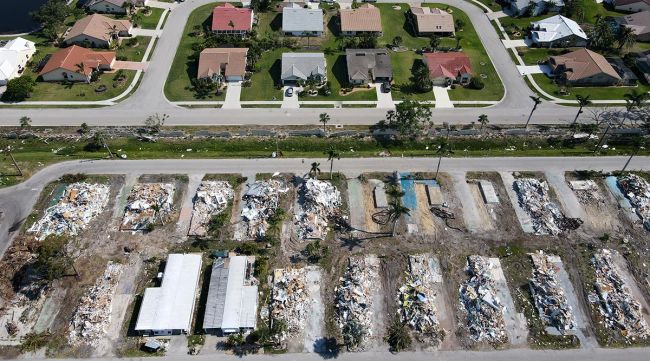The remains of a mobile home park in Fort Myers, Fla., are seen in May, six months after Hurricane Ian ravaged the area. (Rebecca Blackwell/Associated Press)
After predicting a “near-normal” hurricane season in May, federal experts revised their forecast Aug. 10 and said they are now expecting an above-average number of storms in 2023, as record-high ocean temperatures create favorable hurricane conditions.
Forecasters at the National Oceanic and Atmospheric Administration project that between 14 and 21 named storms could form this season, with six to 11 reaching hurricane status with winds of 74 mph or greater. Of those, two to five could become major hurricanes.
That’s up from the agency’s initial forecast issued in late May, which predicted 12 to 17 named storms, with five to nine growing into hurricanes. Over the past three decades, an “average” season has produced 14.4 named storms, with roughly half of those turning into hurricanes.
The updated forecast comes as the calendar has turned to August and the most active part of hurricane season gets underway. Roughly 90% of storms each year form between the months of August and October, said Matthew Rosencrans, NOAA’s lead hurricane forecaster. Hurricane season officially ends Nov. 30.
The same factors that drove NOAA’s May prediction — the onset of El Niño conditions and the exceptionally warm sea surface temperatures — are again behind the agency’s new forecast.
The update to the 2023 Atlantic hurricane season outlook calls for 14-21 named storms, 6-11 hurricanes & 2-5 major hurricanes. https://t.co/G5IhGIvxfl#HurricaneOutlook pic.twitter.com/4Rr8xjEoOq
— NOAA (@NOAA) August 10, 2023
El Niño is characterized by warmer-than-normal temperatures in the tropical waters of the Pacific Ocean, and it tends to push strong westerlies across the Caribbean and the Atlantic, which can tamp down hurricane formation. Rosencrans said Aug. 10, however, that the wind shear typically associated with El Niño has not been as strong as expected, making conditions more favorable for tropical storm development.
Ocean temperatures, meanwhile — the main fuel source for hurricanes — have been breaking records.
Global sea surface temperatures have been abnormally high since April and shattered records in July, according to the Copernicus Climate Change Service, the climate monitor for the European Union.
In June and July, sea surface temperatures in the primary hurricane development region of the North Atlantic stretching from the west coast of Africa to Central America were the warmest observed since 1950, Rosencrans said.
“Warm waters are conducive to more development,” he said.

Host Michael Freeze clarifies the differences between predictive and preventive maintenance. He gives fresh commentary on everything from how enhanced connectivity boosts your preventive maintenance plans to what predictive possibilities AI can offer your shop. Tune in above or by going to RoadSigns.ttnews.com.
Adding to the risk is climate change, which has tipped the odds in favor of more destructive storms.
With higher global sea levels, storm surge can more easily swamp coastal areas and push farther inland. Warmer air temperatures also mean storms can dump more rain in a short period of time, raising flood risk.
Rosencrans urged Americans to prepare now for the storms that may be on the horizon.
“Get your family and your business prepared for the upcoming season because it really just takes one storm coming through your area,” he said.






